Programmable Logic Controllers: A Comprehensive Guide
Programmable Logic Controllers (PLCs) are electronic devices used to control machines and processes in manufacturing and industrial settings. They were first developed in the 1960s and have since become an integral part of modern manufacturing. PLCs automate repetitive tasks and control processes, resulting in improved efficiency, increased production, and reduced costs.
A PLC comprises a processor module, input/output (I/O) modules, and a programming device. The processor module is the brain of the PLC, executing the program that controls the machine or process. The I/O modules interface the PLC with the sensors and actuators used to control the machine or process. The programming device is used to create and modify the program that controls the machine or process.
PLC programming uses specialized software that allows the programmer to create a program that controls the machine or process. The program is written in a language called ladder logic, a graphical representation of the program. Ladder logic uses symbols to represent the various functions of the PLC, such as input, output, and conditional statements. The programmer creates the program by drawing the ladder logic diagram using the software and then downloading the program to the PLC.
One of the key advantages of PLCs is their flexibility. The same PLC can be used to control multiple machines or processes, and the program can be easily modified to accommodate changes in the process. This allows manufacturers to quickly adapt to changing market conditions and customer demands.
Another advantage of PLCs is their reliability. PLCs are designed to operate in harsh industrial environments and can withstand temperature extremes, humidity, and vibration. They are also less prone to failure than traditional mechanical controls and can be quickly and easily replaced if they do fail.
PLCs have been used to control a wide variety of machines and processes, including conveyor systems, assembly lines, packaging machines, and robotic systems. They have also been used in the automotive industry to control the manufacturing process, and in the food and beverage industry to control the production of food and beverages.
In summary, PLCs are an essential component of modern manufacturing and industrial processes. They provide increased efficiency, improved production, and reduced costs. Their flexibility and reliability make them an ideal choice for controlling a wide variety of machines and processes. With the continued development of technology, it is likely that PLCs will continue to play an important role in manufacturing and industrial processes for many years to come.

原文地址: https://www.cveoy.top/t/topic/n2ni 著作权归作者所有。请勿转载和采集!